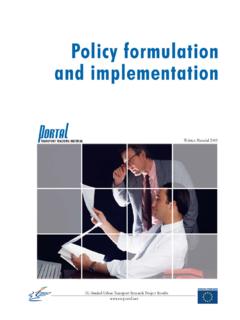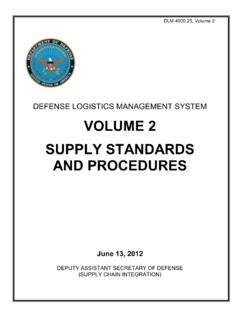Transcription of Sustainable fleet management guide - Eltis
1 MAYOR OF LONDONT ransport for London Transport for LondonSustainable fleet management guide Page 2 of 46 Contents Foreword .. 3 1. Introduction .. 4 What is the guide ? .. 4 Who this guide is for? .. 4 Why is it important? .. 4 How to use this guide .. 5 2. Developing a Sustainable fleet management strategy .. 7 Principles of Sustainable fleet management .. 7 The Sustainable fleet management process .. 9 Stage 1 Assessing current performance .. 9 3. Vehicles and the environment .. 14 Air quality .. 14 Climate change and carbon emissions .. 15 4. Managing mileage and fuel .. 17 Step1 Monitoring and setting targets .. 18 Step 2 Managing and reducing mileage .. 21 Step 3 Managing and improving fuel efficiency .. 25 5. Vehicle and fuel technology .. 29 Latest technology petrol and diesel vehicles .. 29 Electric and hybrid vehicles .. 30 Gas vehicles .. 33 Biofuels .. 34 Future technologies.
2 36 Comparing the technologies .. 36 6. Choosing a fleet .. 38 Assessing the options .. 40 Incentives to help make the switch .. 40 Incentives for staff to use the preferred 41 Page 3 of 46 Foreword Advances in vehicle technology, communications systems and management techniques provide us with a great opportunity to develop a transport network that is Sustainable and adaptable to the demands of the 21st century, with improved journey time reliability, fewer accidents, reduced congestion and a better environment. fleet managers have a pivotal role in delivering these benefits. As major purchasers of new vehicles you are central to the adoption of newer, cleaner technologies into the vehicle fleet . As coordinators of business travel, deliveries and services you can help to improve vehicle use, reduce congestion, improve journey time reliability and save your business money.
3 As providers of driver training you can also improve safety, while reducing emissions and saving fuel. This guide is intended to assist with the process of implementing Sustainable fleet management , and help identify current strengths and weaknesses, and priority areas for improvement. It has a particular focus on cleaner fuels and technologies, and how to select those best suited to individual operational needs. In 2012, along with many European cities, parts of London still do not meet EU targets for the most harmful pollutants affecting health and everyday quality of life, and further reductions in emissions from road transport will have to be achieved. The measures described in this guide will help the fleet industry play its part in delivering these improvements while achieving benefits for a range of businesses, including: Reduced fuel and vehicle costs Improved operational performance Money and time savings through more efficient travel policies and practices Reduced emissions that contribute to air quality and climate change Improved reputation which, in turn, can lead to competitive advantage Clearly, there is no one-size -fits -all solution.
4 Different solutions will benefit some employers more than others, but there are very real savings to be made as shown by the examples in this guide . By working together we believe we can positively influence the transport choices made and deliver a fit for purpose solution that will reduce the impacts of your fleet on your bottom line and the environment. Iain Macbeth Business Engagement Programme Manager Page 4 of 46 1. Introduction What is the guide ? This guide provides practical advice to fleet managers on how to implement Sustainable fleet management practices that contribute to environmental targets and reduce transport costs. This guide illustrates how a sustainably managed fleet can: Minimise fuel costs and optimise carbon dioxide (CO2) based tax liabilities Adopt efficient journey planning techniques to reduce mileage, minimise exposure to congestion and make more efficient use of company transport Adopt new, low emission, vehicle technologies and fuels that are most appropriate for individual business needs Reduce accidents and associated risks and costs through improved driver performance, and provide a safer fleet as part of health and safety responsibilities Support corporate sustainability goals, for example, under ISO 14001 and other environmental reporting requirements Provide a competitive edge by demonstrating environment credentials in a market where these are becoming increasingly important to clients Who this guide is for This guide is designed to help those who have managerial or financial control over a fleet of vehicles.
5 This could range from the fleet manager to the company secretary, department secretary or facilities manager. It will prove particularly helpful to those organisations with fleets of light duty vehicles (cars and vans). Why is it important? fleet vehicles are an essential part of the transport system and vital to successful business operations. However, fleet operators are under growing pressure from rising fuel costs, congestion and the need to reduce environmental impacts. The need to meet national targets for reductions in greenhouse gas (GHG) emissions from commercial vehicles requires further efficiency improvements as poor air quality continues to be a problem in urban areas like London requiring measures such as the Low Emission Zone (LEZ). The advice in this guide can therefore help your business respond to: Rising fuel costs Compliance with environmental regulations and emission-based restrictions on vehicles such as the LEZ Increased pressure on employers to take responsibility for the health and safety of employees while driving on company business Page 5 of 46 Meeting the requirements of environmental management systems, for example, ISO 14001 Demands from customers for improved environmental performance and reporting Up to one in three road crashes involves a vehicle being driven for work Every week, this results in around 200 work-related deaths or serious injuries For the majority of people the most dangerous thing they do at work is drive on the public highway Department for Transport (DfT)
6 How to use this guide The remainder of this guide provides information and advice on how to implement the principles of Sustainable fleet management . Section 2 describes the basic principles and processes of establishing a Sustainable fleet management strategy Section 3 provides an overview of the main environmental impacts of vehicles Section 4 describes the methods for managing vehicle fuel and mileage Section 5 describes the vehicle and fuel technologies available to help reduce emissions Section 6 describes how procurement processes can be adapted to improve the environmental performance of the vehicle fleet Additional information and tools are available on the Transport for London (TfL) website at Some of the topics mentioned in this guide are covered in more detail in other TfL guidance, in particular: Smarter Working Sustainable business travel In addition, TfL s Freight Operator Recognition Scheme (FORS) and its associated freight micro-site provides advice for operators of light and heavy goods vehicles at Appendix 2 provides additional sources of guidance on the topics discussed.
7 Page 6 of 46 Corporate environmental reporting An increasing number of organisations are publishing environmental data alongside financial data as part of their corporate reporting process in annual reports and environmental statements. This is being driven by shareholders, suppliers and customers demanding greater openness on the environmental impact of business, and is an aspect of lending criteria by financiers. Climate change and GHG emissions are a key reporting area for environmental management systems and many organisations are reporting carbon footprints of their products for the benefit of consumers and whole life reporting costs. Tra nsport emissions are generally a significant element of these carbon footprints. More information on environmental and GHG reporting can be found at Page 7 of 46 2. Developing a Sustainable fleet management strategy Principles of Sustainable fleet management A Sustainable fleet management strategy is one that aims to reduce environmental impacts through a combination of cleaner vehicles and fuels, fuel -efficient operation and driving; and by reducing the amount of road traffic it generates.
8 In doing so the fleet minimises fuel and vehicle costs and improves the safety and the welfare of employees while reducing its exposure to the problems of congestion. The strategy will also help you to meet the requirements of other policies within your organisation; for example, business efficiency, health and safety, equalities and inclusion, and corporate social responsibility (CSR). Increasingly, businesses are measuring and reporting their carbon emissions, including those arising from their transport activity known as Scope 3 emissions. This is discussed in more detail later in the guide . A Sustainable fleet strategy is based on three key types of measure: Transport demand management aim to reduce the miles driven. Look at whether trips are necessary, and consider if they can be combined and whether the optimum routes are being used. By examining current practices, significant mileage savings can be made, thereby reducing fuel and mileage costs, emissions and even the size of a fleet Cleaner fuels and technologies aim to use the lowest emission vehicles appropriate to their role.
9 With existing diesel and petrol vehicles, use the smallest, most efficient vehicle appropriate for the job. Explore new, low emission technologies such as electric vehicles (EVs) or sustainably produced biofuels that may be suitable Efficient vehicle use ensure that vehicles are being used as efficiently as possible and using the least amount of fuel. The key areas here are driver performance and vehicle maintenance, as both have a significant impact on fuel. Reducing fuel use will cut emissions and running costs Page 8 of 46 Central to Sustainable fleet management is the principle that you can t manage what you don t measure . The different measures are all based upon ongoing monitoring and target setting to ensure that performance is assessed and continuously improved, as illustrated in Figure 1. Figure 1: Transport demand management Sustainable fleet management has implications for many areas of business management , for example: Vehicle procurement and specification Business travel policies Company car allocation policies Heath, safety and environmental policies logistics management Supply chain management and distribution management and scheduling of sales staff, service calls etc Procure efficient and low emission vehicles Optimise operations and vehicle use Transport demand management Monitoring and target setting Page 9 of 46 The Sustainable fleet management process The process of establishing a Sustainable fleet management strategy is summarised in Figure 2.
10 Figure 1: S tages in developing a Sustainable fleet strategy Stage 1 Assessing current performance The first stage in developing the strategy is to gain a thorough understanding of current fleet operations and costs, existing business policies and processes. This stage ensures you have the data to develop an informed fleet strategy . The Sustainable fleet management checklist in Appendix 1 provides a simple template to take you through the process of information gathering under the following areas: What existing fleet policies do you have? What monitoring do you undertake? What measures do you undertake to minimise vehicle mileage? What do you do to encourage fuel efficient vehicle use? What do you do to ensure you use the cleanest and most efficient vehicles and fuels? Working through the checklist can help identify those actions that are already being taken and potential opportunities for further improvement.



